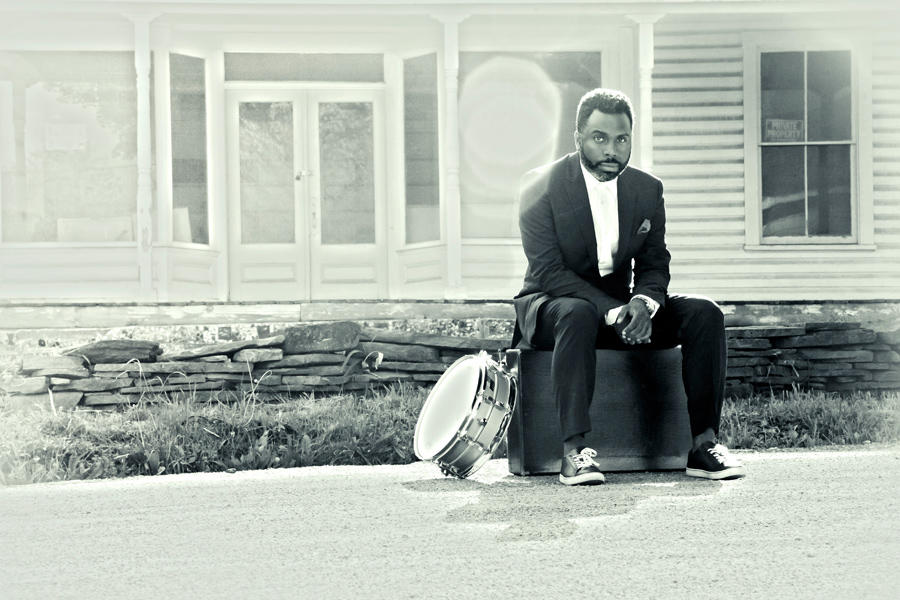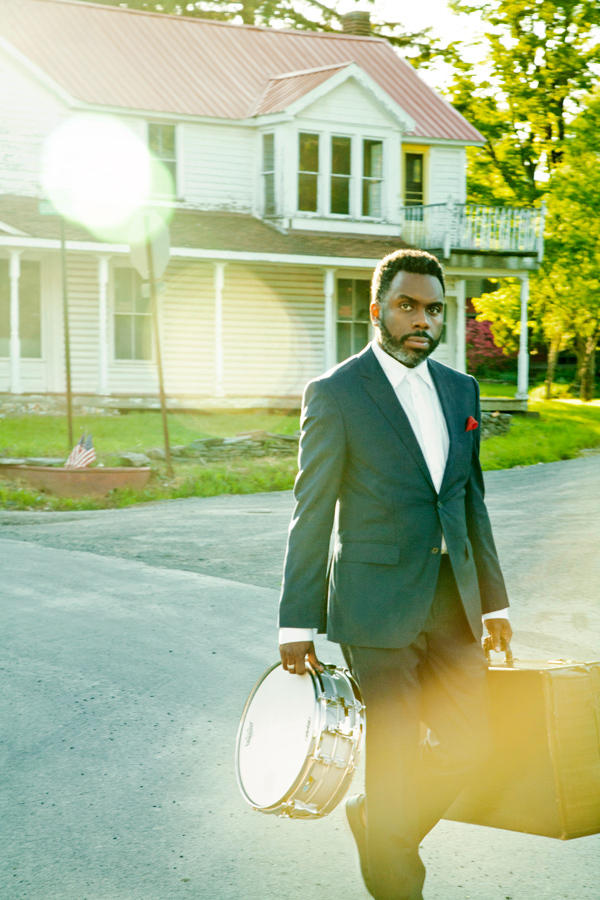SOUND PROJECTIONS
AN ONLINE QUARTERLY MUSIC MAGAZINE
EDITOR: KOFI NATAMBU
FALL, 2020
VOLUME NINE NUMBER TWO
B.B. KING
Featuring the Musics and Aesthetic Visions of:
BRANDEE YOUNGER
(October 31-November 6)
CHRIS DAVE
(November 7-13)
MATANA ROBERTS
(November 14-20)
NATE SMITH
(November 21-27)
T.J. ANDERSON, JR.
(November 28--December 4)
KEYON HARROLD
(December 5-11)
NICOLE MITCHELL
(December 12-18)
OLLY WILSON
(December 19-25)
KENDRICK LAMAR
(December 26-January 1)
JONATHAN BAILEY HOLLAND
(January 2-8)
WENDELL LOGAN
(January 9-15)
DONAL FOX
(January 16-22)
https://www.allmusic.com/artist/nate-smith-mn0001369693/biography
Nate Smith
(b. December 14, 1974)
Artist Biography by Thom Jurek
Smith was born and raised in Chesapeake, Virginia. At 11 he began playing drums and learning piano by ear. His earliest influences were in rock and funk; among his favorites were the Police, Earth, Wind & Fire, and Quincy Jones. His musical world-view was altered forever upon hearing Art Blakey & the Jazz Messengers at age 16. He pursued music and media studies in high school and earned a scholarship to James Madison University, where he earned a B.S. in media arts and design in 1997. During his collegiate years, Smith was heard and recruited by jazz singer Betty Carter to participate in her esteemed Jazz Ahead program (whose alumni include Jason Moran, Cyrus Chestnut, Jacky Terrasson, and Casey Benjamin). He pursued postgraduate work at Virginia Commonwealth University as a member of the Carpenter Fellowship Program. During his tenure there he met and performed with Holland. He became a full member of his acclaimed quintet in 2003, as well as the Dave Holland Octet and Big Band. Potter, also a member of the bassist's quintet, recruited Smith to join his band Underground in 2004.
Smith worked in studios and on the road with an array of artists including Ravi Coltrane, Nicholas Payton, Regina Carter, John Patitucci, Adam Rogers, and Lionel Loueke in addition to the pop artists named above. In addition to his work as a musician, Smith is an educator. He taught Betty Carter's Jazz Ahead program at Kennedy Center in 2013 and 2014, and during the latter year, at the Thailand International Jazz Conference. In 2015, he was artist-in-residence at his alma mater, James Madison University.
https://musicians.allaboutjazz.com/natesmith
 Nate Smith
Nate Smith
Ira Nathaniel “Nate” Smith (b. December 14, 1974) is an American drummer, composer, songwriter and producer.
Born and raised in Chesapeake, Virginia, his musical talent became apparent at the age of eleven, after picking up the drums and learning to play the piano by ear. After high school, he went on to earn a percussion performance scholarship and pursued his musical studies at James Madison University, where he received a B.S. in Media Arts and Design in 1997. While still in college, Nate was recruited by the great jazz singer Betty Carter to participate in her esteemed Jazz Ahead program, which has produced an impressive list of alumni including Jason Moran, Cyrus Chestnut, Jacky Terrason, and Casey Benjamin, among many others. After college, he was invited to continue his studies at Virginia Commonwealth University as a member of the Carpenter Fellowship Program. In graduate school he met and performed with the legendary jazz bassist and composer Dave Holland. He continued to perform occasionally with Dave over the next few years, finally joining his GRAMMY-award winning Quintet and Big Band in 2003. In early 2004, he joined saxophonist Chris Potter’s group Chris Potter Underground, and has since recorded three albums with the ensemble. Since then, he has gone on to play or record with an array of fantastic and diverse artists, including: Ravi Coltrane, Jose James, Nicholas Payton, John Pattituci, Adam Rogers, Regina Carter, Mark de Clive-Lowe and Lionel Loueke. In 2012, Mr. Smith did a 35-City US/Europe tour with pop songwriting legend Joe Jackson. He has appeared on The Today Show, Late Night with Jimmy Fallon, The Late Show with David Letterman and Conan. He was featured in the October 2012 issue of Modern Drummer magazine, and a full-length web interview with iDrum magazine.
Mr. Smith is also an esteemed educator, having served on the faculty of Betty Carter Jazz Ahead at The Kennedy Center 2013 and 2014 as well as The 2014 Thailand International Jazz Conference. In March 2015, he will be the featured Artist-In-Residence at his alma mater James Madison University.
Regarding his new project, KINFOLK, Mr. Smith says “In conceiving this project, I wanted to focus on creating the material with very few ingredients; just improvising at the drums or piano or singing ideas into a voice recorder, focusing primarily on rhythm and melody. I want to see what other ingredients the players or singers would bring to the material. I’m interested in a true band sound: I want to know how the musicians will color, shape, and season the raw ingredients, and how to pull all of those pieces together to a whole.”
Thursday, April 20, 2017
Nate Smith Brings it Home with "KinFolk: Postcards from Everywhere"
“Bounce Parts 1” starts off with a funky beat that folds into a complex dual horn line with guest Chris Potter on tenor and Jaleel Shaw on alto. Guitarist Jeremy Most lays on some funky licks to the mix and Ephron’s bass is elastic but firmly grounded. “Bounce Part II” changes to an airy cosmic groove that offers the ebullient tenor man Potter some room to expand one’s consciousness, and he does so with an earnest solo that elevates impressively.
http://www.natesmithmusic.com/
http://www.natesmithmusic.com/bio

Nate Smith. Photo by Deneka Peniston





For nearly two decades, Nate Smith has been a key piece in reinvigorating the international music scene with his visceral, instinctive, and deep-rooted style of drumming. He holds a diverse and ample résumé — which includes work with esteemed jazz leading lights such as Pat Metheny, Dave Holland, Chris Potter, José James, John Patitucci, Ravi Coltrane, and Somi among many others. His 2x GRAMMY-nominated debut album, KINFOLK: Postcards from Everywhere, sees Smith fusing his original modern jazz compositions with R&B, pop, and hip-hop. He’s also ventured into the pop/rock world with recent collaborations with Vulfpeck spinoff band The Fearless Flyers, Brittany Howard (of Alabama Shakes) and performances with songwriters Emily King and Van Hunt. In recent years, through a series of viral videos, he has emerged as one of the most influential and popular drummers of his generation. His videos have been viewed millions of times and have inspired countless musicians and fans. In September of 2018, he released his first ever solo drumset album Pocket Change.
As a composer and arranger, Mr. Smith received two (2) GRAMMY nominations for his composition “Home Free (for Peter Joe)” for best instrumental composition and best arrangement (instrumental or a cappella). Of the KINFOLK: Postcards From Everywhere project, Mr. Smith says: “It was my goal to start with the simplest of elements, singable melodies with familiar harmonies, and use them to weave stories that felt nostalgic without being overly sentimental. Pieces like ‘Retold’ and ‘Pages’ use familiar, consonant harmonies as a means of evoking the listener to “reach back” for a memory, while ‘Skip
Step’ and Spinning Down’ use layers of rhythm to express a feeling of unsettled tension. ‘Disenchantment: The Weight’ uses an ascending/descending chord progression to simulate a deep sigh of resignation, while ‘Home Free (for Peter Joe)’ uses a hymn like melody as a means of evoking feelings of both solemnity and ceremony.
Mr. Smith currently lives and works in NYC.
https://www.moderndrummer.com/2012/08/nate-smith/
Nate Smith

As a member of Dave Holland’s big band, quintet, and octet, Nate Smith holds, well, three of the most cherished gigs in jazz. Holland, a revered bass player who started his own musical quest with Miles Davis in the ’60s, has nurtured many a drummer in his high-octane ensembles, and the thirty-seven-year-old Smith is well equipped to carry on the legacy.
Beyond his jazz drumming duties, which he also pursues with tenor saxophonist Chris Potter, vocalist Claudia Acuña, guitarist Adam Rogers, and others, Smith is an adept R&B and soundtrack producer. His music has been heard on PBS and the Discovery Channel, and his album productions include the soul artists YahZarah, Maya Azucena, John Gordon, and Shanta “Bunmi” Jasper. Most recently he produced and mixed Jarrard Anthony’s Ready to Live. Smith even cowrote and coproduced “Heaven Can Wait” for Michael Jackson’s Invincible album.
Almost completely self-taught, Smith has developed a confidence that has allowed him to thrive in multiple formats. We sat down with Nate to discuss how his various roles coexist.
MD: You’ve produced a lot of soundtrack material. Does that require you to turn off your drummer’s brain?
Nate: Actually, I use a lot of my drummer’s brain then. Sonically, I use the drums to create a certain atmosphere. Most of the tracks that I’ve produced or scored start with the drum track. That establishes the basis for how the rest of the piece will unfold.
MD: What’s your process for creating a soundtrack?
Nate: I recently scored a trailer for a PBS documentary called Soul Food Junkies. The colors used in the trailer were warm, and the clips were of people discussing the traditions of food. Initially I was going to create this electro dance thing, but it didn’t work; the visuals and the dialogue didn’t match up. So I used an old track of mine, slow funk, almost a church-like groove, that was in 7/4. When the producers originally sent the visuals, I went through a bunch of older material and lined it up [with the footage]. We sent it back and forth, and I got more ideas. Then we settled on my final track.
MD: You play funk and fusion as authentically as straight ahead, which is still rare among drummers. How did you gain that versatility?
Nate: Drummers are often typecast. People assume you’re better at one thing than you are at another. But if you really check out Brian Blade on one hand and Dennis Chambers on the other and acknowledge their greatness, there’s no limit to what you can do. I believe in osmosis—things rub off. The more you open your mind, the more [your style] will come out. Of course you shed and try to break down the drummer’s style, but the more you check them out technically and musically, the more it will come out of you. Stick control is a big part of it—just dynamic control, which comes from shedding rudiments. Then you learn to apply them to the drumset without sounding literal or clinical. Keep it warm and musical.
MD: Did you audition for Dave Holland to get the gig?
Nate: I met Dave in 1997 while I was in graduate school at Virginia Commonwealth University. He was a guest artist, and we played his big band charts and some new small-group music. We learned the music and immediately started playing. I think he really dug that I was so excited to play with him. We were nailing the odd time signatures. We were playing free and landing on the 1. At the concert he said he enjoyed my playing and that he would call me. I was awestruck. He called me for two gigs and then a short tour in 2002.
MD: How did you adjust to the new gig?
Nate: I listened to Dave’s whole catalog and lived with it for a long time. It sounds difficult, and it is difficult, but it’s fun. His music always sounded like fun to me, from the moment I heard it. Every time we played, he would give me a little more insight. He never really told me what to do. We never over-rehearsed. We’d go on tour and he’d point out a couple things.
MD: Without an instructor early on, who taught you to hold the sticks correctly?
Nate: My director in concert band. My brother was in marching band, and he was a big influence, so we had lots of material in the house relating to drumming. I’d watch tapes of when he was in marching band, and I figured it out. Once, on a gig in New York, Ralph Peterson Jr. came up and corrected my left-arm position! I was playing with Betty Carter as part of the Jazz Ahead band. My left arm was kind of tight, which it still is sometimes. Ralph came up after the gig, placed the drumstick in my hand, and pulled my elbow out. He said, “Just tap your knee,” then he pushed my arm back in. And I could tell the difference. When I pulled my arm out I could do all kinds of stuff. That was incredible.
MD: How did you develop your touch on the cymbals?
Nate: Jack DeJohnette is a big influence on that. I’ve watched a lot of video of him with Keith Jarrett, and he is so relaxed. He’s such a beautiful colorist on the cymbals. You can apply the different shades of colors he gets out of the cymbal to all genres of music.
I don’t really play crash cymbals. I use rides as crash cymbals. I like that dark, whispery sound. That’s an extension of the stuff I learned watching Jack. You can get a ton of sounds out of the cymbal, depending on where you touch it. Jimmy Cobb is an influence as well, the ’58 sessions with Miles Davis, and Kind of Blue, of course. Just his quarter-note pulse on the ride cymbal—that changed my life. I mimicked that. Billy Hart once told me that cymbals should sound good on their own, but cymbals are there to make the band sound good; that’s the point.
MD: Are there a couple of chops builders you depend on?
Nate: Flam rudiments helped me build up left-hand articulation. And you should enjoy practicing. Greg Hutchinson says, “If you’re practicing and you’re looking at the clock, you shouldn’t be practicing.” You should be playing; then, when you stumble on something you have trouble with, work it out. Shed that specifically. But it all should be a means to a creative end. There should be a creative spark.
MD: It seems that Dave Holland always wants the drummer to drive his band.
Nate: Absolutely. He’s never expressed any objection to that. It’s always felt good to him when we’ve played together. And if you look at the drummers he’s played with over the years, from Billy Kilson to Marvin “Smitty” Smith to Jack DeJohnette, he likes that energy, that power. Dave never puts a lid on anything. He’s like, “Play your stuff.” He might say, “Let’s change the shape of this,” for instance. But in general he’s very open to the idea of just playing freely.
https://www.wvtf.org/post/jazz-drummer-nate-smith-postcard-virginia#stream/0
Jazz Drummer Nate Smith: A Postcard from Virginia
Josh Jackson spoke to drummer Nate Smith about his recording Postcards from Everywhere.
Tell me who you are and what you had for breakfast today.
Okay. I'm Nate Smith and I had two eggs scrambled with sausage and wheat toast, and it was delicious. It was delicious. It was everything I dreamed it would be.
What does one dream it to be? What were you expecting?
Listen, when I’m in Roanoke man, it feels like home. My grandmother lived in Salem. So I think of Grandma's breakfast when I'm here. I think of like the country and that feeling, when you wake up, and you're like, “Oh okay”. You know, my grandmother was old school, man. Up at 5:30 baking biscuits from scratch. She was that one.
I didn't know that you were from Salem.
My mother is from Salem. I'm from Chesapeake, but we would come to visit Salem often. We'd be here for a couple of weeks every summer and we’d come up for Thanksgiving, you know, every year. So I got to know Salem pretty well.
Tell me a little bit about grandma then.
Irene Helm, my mother's mother. She was a beautiful woman, very funny. She was the type of person that as soon as you walked into her home she wanted to feed you something and she was known to, out of the blue, order my mom to go in the kitchen and whip up something for people to eat, just out of the blue. We'd be sitting around and there'd be a lull in conversation, she would say, “Why don't you go in the kitchen and fry up about three eggs for everybody.” And that was sort of her thing. It was like everything was about her welcoming you into the house and making you feel at home. She was great. She worked as a domestic for most of her life and she had five kids with her husband, my grandfather, Booker T Helm. Seems like every black family has a Booker T.
Right?
Yeah. Every black family has a Booker T somewhere in the lineage
And Booker T. Washington was born literally on a plantation not too far away from where you and I are right now in Virginia
Wow. I did not know that.
In Franklin County just past Rocky Mount there is a national monument to Booker T. Washington.
Nate Smith joins us here on Last Quarter. I'm Josh Jackson. The recording is
Kinfolk: Postcards from Everywhere.
And congratulations by the way. I've been following you for a while, and I listened to Waterbaby when it came out. And then I think when you were 40 you made a little mixtape or something.
I did. Kinfolk is actually my fourth record. All my records before that had been R&B, kind of produced R&B records, so a lot of programming and I was playing all the instruments. But I did a record called Workday in 2008 and then a record called Scrapbook in 2011. And then when I turned 40 I did this little eight track beat tape that I put out. And it's all just been like something to just put music out. But this was the first bandleader effort, and this is certainly the biggest project I've ever done, because there are a lot of people on this record, a lot of folks.
It is from everywhere, and also everywhere in your own development as an artist. I mean Adam Rogers the guitarist is on this, and you play with him in a group called Dice. Dave Holland is on this recording.
Absolutely.
I wanted to back up for just a moment. Since you were talking about your grandmother, it sort of reminded me of one of the first people that you worked with in the jazz canon, and that is Betty Carter.
Yeah, of course.
And I recall also from Waterbaby that you did something for her. There's like this sound bite of her where she's basically saying, “You have to be an individual and somebody that people will remember.”
Absolutely. You know there were a lot of lessons learned from the brief time I worked with her. I met her in 1996. She passed away in ‘98. So I didn't have that much time with her, but you know she was a natural teacher, so you couldn't be around her without learning something. Especially if you’re a musician and an impressionable musician of that age, you're going to soak up everything she has to say.
But she was that too. She was an individual. You know I really believe, and she said it once too, that in a way she was the last jazz singer. Because she's the link I think, in the chain that ties together a singer like Sarah Vaughan or Ella to a singer like Cassandra Wilson or even Gretchen Parlato. I think Betty is that link. And what she did with form, what she did with melody, the liberty she took, the way she was able to stretch - she was just so musical and so unique, really unique. So I took that to heart. That snippet is from a CBS Sunday Morning profile they did on her and I'm featured in that profile. In 1996 I was, I guess, 21 years old and they did that. And yeah, it was a trip just to be around her and witness her. It was incredible.
Tell me a little bit about that Jazz Ahead program, because she sort of plucked you out of, I guess, Chesapeake Virginia.
Yeah. In the summer of 1995 I did the Disney Grammy band in Epcot, and in that band was a young trombonist named Andre Hayward from Houston. Great trombonist, played with Lincoln Center. I think he lives in Dallas now. But just an amazing musician, and a really great guy. And he heard me and said, “Listen, Betty should hear you. So you know I'm going to tell her about you”. And I said, “Yeah great”. And he did. And the following January, (this was July of ’95, so January of ’96), now I guess it doesn't exist anymore – the IAJE - there was this conference they used to do every year.
The International Association for Jazz Education.
Right. And so they would bring different student groups. So my band from JMU got selected to go to IAJE, and Betty was there, and she heard maybe 10 or 15 minutes of our set. And then she came up to me afterwards and said, “You know I like the way you play. I want to talk to you about Jazz Ahead.” And I was like, “Okay.” And a few months later I got the call. She was like, “I want you to come to New York and play.” And the first year I did it, there were three drummers – myself, Byron Landham from Philly, and a young drummer from Houston named Eric Harland. And I can tell you Eric sounded every bit as clear, and his ideas were just as beautiful then as they are now.
Were yours?
I don't know. I don't know. Great question! You know I'd like to hope that I've gotten better. Eric has always been great, he's just gotten more great. I certainly hope that there's a core of my playing, like a personality in my playing, that's been there since then, that's still there. And I think it has. And I do think that I've certainly learned how to play in different situations much better now, since Jazz Ahead. But sort of wrapping it up, doing that - being in Jazz Ahead - kind of really changed my trajectory, because it exposed me for the first time to musicians my age who were playing at that level. And it just inspired me to work harder and it really made me think seriously about New York. I flirted and dreamed about the idea of moving to New York and flirted with the idea, but it was being in that situation made me know eventually I'm going to have to make this move from Virginia to New York.
And yet here you and I are in Virginia and having this conversation.
Nate Smith Kinfolk is performing at the Jefferson Center in Roanoke.
And you've also been conducting a workshop or teaching students. Tell me a little bit about what you're doing.
So you know the Jefferson Center has this really cool music lab that they are using to teach kids about songwriting and production and recording, and it's just a really great resource. It's something I wish I’d had when I was a teenager. You know, to be surrounded by people who are encouraging you to just kind of examine your curiosity in different parts of the music business. So I've been there. Last night I was there and we have three songs that we're working on while I'm here. So there was a singer songwriter I worked with last night, who's working on our pop record. And then there's this four-piece rock band that I'm working with tonight, and then tomorrow there's a gospel group that we're going to work with. We're trying to put together a record for each one of them. And I'm going to sort of be producing the record and kind of coaching the kids on how to perform it, and it's really cool. A nod to Cyrus and Jessica and Jordan, and everybody who runs that place. They're really doing something very cool over there, and something that I think these kids can take with them. Whatever they choose career wise, they can take this stuff with them, these experiences, and say, “Okay, I learned something from this.”
And you just never know what kind of impact you make when you meet a kid at that age. Having been that age, and thinking back to when I was, there were, even before Betty, a number of impressions that were made on me by musicians, that I think I've always taken with me. And I hope I can kind of make some of those impressions on them, that they take with them, forward.
Nate Smith joins us. Kinfolk is the band, and Postcards from Everywhere is the recording.
Speaking of reflections, I kind of feel like this entire recording is based on some kind of reflection about who you are, how you've gotten to this point in your 40s, and kind of just looking over your shoulder and figuring out how did I get here, and why.
Yeah it is, and I feel like I released this record at 42, and by the time most cats are my age, bandleaders, they've released several records. So this is my first bandleader record and it's happening kind of late in my career. So I felt a need to sort of give a little back-story. Not only just for my own expression, but also to give the audience an idea of who I am and where I'm from. And there was something, like around 2012/2013, I just started thinking about it like, “Okay. Here I am. How did I get here? What were the choices I made along the way? Who were the people that helped me?” And it started to kind of form something. But the music was always kind of the guiding thing. If the music had been about something different, than maybe the record would have had a different tone. But there's a lot of that feeling of nostalgia and narrative in the music, so I wanted it to feel that way throughout the entire project. Not only just the way the record sounds, but also the interludes with my parents and the artwork itself. I mean everything about it is about storytelling.
Let's talk a little bit about “Home Free”.
The reason why I want to talk about it more than anything is because I think it was right around Father's Day, if not on Father's Day, there was a video that you released. And at first I looked at it and in my sort of skepticism, I thought, “Well it's an EPK - an electronic press kit - about this record.” And then by the end of it, I had goose bumps. And I thought, “No, actually I think this might be a remarkable piece of citizen journalism.” And it just so happens to be that you have a recording. And it's about the men in your life.
Yeah it is, about particularly two of them - my father and grandfather. The song was written for my grandfather. And over the course of the recording of my record, my father passed away. So it just felt like a befitting tribute that the song takes on a dual meaning. It's not just about Peter Joe, it's about dad too. And there's an interlude on the album just before the song that features my dad, talking about his dad. So there is, I just felt, a sort of convergence. The film was directed by this great director, Jim McGorman from Philly, and I worked with him. He did a documentary about Chris Potter a few years back called “Open Minds”. He's really great and he came down to New York and we did it in a day. He followed me around. You know, he's just capturing me. I didn't even know he was shooting half the time. He's really great. So then we went to the studio. We had Jaleel and Fima on the video.
Jaleel Shaw and Fima Ephron
...Who play alto sax and bass on the record respectively.
It was just a really heartfelt and sincere tribute to them. You know we hear a lot of stuff about the men in our lives. Father's Day brings up a lot of conflicting emotions for people. Some people have great relationships with their dad. I was lucky to have that. And some people might not have even known their fathers or had rocky relationships with them. So I just wanted to celebrate what was great about both of those men, and do it in a way that was just sincere. And hopefully the music pays a befitting tribute to them too.
It’s “Home Free” for Peter Joe. It's from the recording by drummer Nate Smith and his band Kinfolk. The recording is called Postcards from Everywhere.
You mentioned something to me recently that your father had a certain obsession with footstools.
He did. He did. My dad, God bless him. He had a woodworking shop in our garage. And he had a lot of really nice gear he bought and he loved it. And he had a sketchbook full of his ideas and I think that was his creative outlet. And he made a lot of stuff that's in the house, like a lot of stuff. Some of it turned out great, some of it not. You know it was a little rough around the edges, but he always just loved doing it and did it because he loved it. And he made a lot of footstools, and there are footstools all over the house.
Are they level?
I mean different heights. Varying, you know. But no, they turned out really good. He was really good at those. The legs are really beautiful and he put these really nice cushions on. Really cool. So he was good at that. He also did some really beautiful tables in our home. I think he was an artist. He worked as a high school principal most of his life. But he definitely had an artistic pursuit. I think it was through the woodworking he pursued that.
And in some sense he created a step up, if I should extend the metaphor, for you. Because I mean the artistic side of him was that he loved music. And so a lot of your early experience with jazz and the history of black music came from him, and finds its way in here.
Absolutely, yeah. That's part of what makes it feel so nostalgic for me and like such a narrative for me, because I absorbed those sounds you know, in the house.
He was playing Quincy Jones and Joe Sample and Bob James - that period of music in the late 70s, early 80s. Before it was commodified as smooth jazz, there was this period where it was just instrumental R&B played by great musicians, who were playing it very sincerely, and recorded beautifully. To the point that when hip hop artists had access to sampling capability, they reached right for these records and found all these perfect loops. So yeah, I absorbed all that music and it sort of comes out in tracks like “Bounce” or “Small Moves” or stuff on the record like that. But no, it really came from him. He loved Quincy Jones records. He always said, “You know I love the way they make my speakers sound. I love the way they make my stereo sound.” That was his benchmark for how a record should sound – a Quincy Jones record. So it starts with him playing records in the house.
Tell me a little bit about “Bounce”. There are two parts.
So “Bounce” is probably the oldest song on the record because I'd been playing that song with Chris Potter's Underground band for many years before I recorded it. But it is basically a song that has this one little instrumental riff that repeats a few times with some open jamming in between it, and then there's an open sort of solo section at the end, which features Chris Potter on the album.
And because we've been playing it so long, and because he's just Chris Potter and he's awesome, but because we've been playing it so long, he just eats it alive on the record. He just tears it up and that second section is sort of a soloist feature there.
And in my mind I was thinking about a record like Tutu by Miles Davis. You would have these tunes that were like just riffs that would repeat, with open improvised sections. Not really solo sections in between, but where the band would just groove in between these two sections. And I really liked that idea you know, and then maybe featuring one musician as a soloist in a second part. But I just love the idea of that environment, and treating the music like a piece of sculpture or something, where the parts are the parts and we kind of stick to playing the parts, and maybe we sprinkle a little bit of stuff. But the actual piece is just what the bass is playing, what the guitar is playing, the melody. Those are the parts and they're fixed.
Like through composed?
Sort of, yeah. Like through composed. And then between those sections again, I'm thinking there's just a point at which we just use those bass line parts – bass, guitar, keys - we use those parts as a launching pad to just sprinkle with small improvisatory ideas. And then we go to the second section where it is more open, and a more extended solo for one player.
Nate Smith, do you find more recently that you're striving for simplicity in some sense? Versus, I mean there's a lot of music that we call jazz that is incredibly complex.
Yeah.
And always perfectly executed right, by great musicians like you. But I think sometimes, maybe more recently, fewer people are getting back to that simple element of a melody that someone can kind of connect to.
Yeah, yeah. I think that there's power in that. I think there's real power in giving people something they can latch on to and take with them, and they can sing in the car or they can sing in the shower, or they can sing, whistle while they're working or whatever. I do think that it becomes the sort of soundtrack of your life in a way. Not to be corny, but I do think that there are moments in your life where you'll think of a melody, and you'll think about where you were the first time you heard it or where you were the first time you sang it, or where you were the first time you heard it live.
It’s not a singular sensory experience of just the ear.
No…
The ear is sending a signal to your brain and there are a lot of other things that that brain remembers.
Absolutely. Your brain remembers every aspect of where you were. You know I can remember listening to some of those records that my dad used to play, and I can remember what mom was cooking in the kitchen, like it’s a full body experience. And I do respect and love what musicians are doing who are playing music that's much more complex, because it's a different type of listening experience, where it's almost like you have to invest your whole body into taking it in in that moment. But if I see people moving in their seats or even if people want to get up and two step while I'm playing, I have no problem with that, because I feel like that's what music is kind of meant to do.
And I really don't have any problem with people having the idea that the music is simple, or that it is designed to be used again and again, to be listened to again and again, and sung again and again. That’s okay with me, that's totally fine. And I don't think that there's anything about that, that makes it less of a jazz record.
Do you design songs to last? I mean some people just kind of say, “This is a snapshot of me right now. This is my recording and I’m going to move on to something else.”
Well whether you design them to last or not, they last forever. This record is going to be around hopefully for a long time and it will outlive me you know. And yeah, I do want it to, too.
I think that as musicians and especially as record producers, people who make records, we’re in the design business, in the same way as someone who creates a piece of art or a piece of whatever. You're creating something that will be used again, and again and played again and again and consumed again and again. And you're like, “Okay, what are the elements of this that I want people to discover after repeated listenings, repeated use?” That’s the thing.
As you design something, you have to consider the user experience.
You have to. I mean I think that's what makes the most successful designers successful, is that they're considering the user. And if you're designing it for musicians to use, that's one thing. So if you're designing it for musicians or journalists or critics or whatever to use it in that way, that's totally fine. And there's nothing wrong with that. But if you're designing it for people who aren't musicians to have access to a musical experience or to use it again and again, that's another thing entirely. Maybe not entirely, but it is another thing, and it is something else that you would consider. I feel like I was lucky in that I was raised around people who weren't musicians, who just enjoyed music. So I have a sense of what people, who don't listen to music in a deconstructive way, expect from music and what they want from it. So I kind of think about that as I make records and make tracks. I'm always thinking about not only my experience, because I experience it as a fan too, but also think about when I listen to it again and again. I listened to Kinfolk for two years before I released it.
Were you a little nervous?
I was a little nervous man! No not at all. Yes I was very nervous. I was definitely. Because it is my first bandleader record I felt the stakes were really high for me. But I also knew that I wanted it to be something different, that would kind of stick out in the landscape of the jazz records that are coming out. So yeah, I considered that as I listened to it again and again. But getting back to this point of creating music for the audience, considering the audience. I do not think that's a bad thing at all. And I don't think it makes anything less than any other type of music or any other type of expression.
Are you considering the audience when you create these drum loops for the Loop Loft? Or can you just only focus so much on that, and then just like, “I’m in this groove and I gotta stick it.”
Yeah. That's really more what it is. It's like I'm in the groove. I'm experiencing it as a drummer first. But I feel like drummers, we have a very interesting vantage point, because so often the drums on any record create the environment.
Oh yes. I have to tell you, just to interject for a moment. I love drummer records. I love Brian Blade and the Fellowship. I love Mark Guiliana's Beat Music. I love Antonio Sanchez's recording Bad Hombre. I always pay particular attention to what's going on with drummers.
I feel like when you're behind the kit, and the kit is the closest thing to you, you have a very interesting perspective about how the band sounds. Because again I feel like this environment that drummers create with sound is unique to any other instrument, to all the instruments on the bandstand. I mean it's a very unique place to be. I think that's why you see so many drummers transitioning into becoming producers and making records, because we have this idea that the drum is kind of the center of the environment, the sonic environment, and the events kind of emerge from that. But so yes, I'm thinking, as a producer, “What kind of groove would I want to play? What kind of snare drum sound would I want to play? What kind of snare drum sound would I want to have access to?” And so the Loop Loft thing, a shout out to Ryan Gruss and everybody at Loop Loft, because he's put something together that's really unique. And a lot of producers have hit me up saying, “I really love these loops. I love the way it's built.” He makes it so easy for them to use it, but he uses real musicians, playing real parts. So yeah, it's a balance of those two things. I'm thinking about myself as a producer, “Would I like this?” You know what I mean? But also, as a drummer, I just want to execute the groove. So you're kind of on a tightrope. But first things first, I'm always thinking as a drummer.
But we know the answer to the question, “Will Nate Smith use Nate Smith on the session?”
Somebody came up to me the other day and said, “Man, I heard you did a loop Loft record. So I guess that means you're going to be on my next album!”
I was like, “Okay, well we’ll have to work out another deal for that, but that's fine.”
But you know I haven't actually done too much programming recently. I've been playing on my own record and demos and stuff, but maybe I'll download my own loop pack or maybe I'll download Mark Guiliana's, or Eric's or Karriem Riggins. I think he's done one, so there're plenty of guys. Yeah I'll use their beats. I’ll put Karriem on my record!
I remember talking to Karriem once and I was like, “When did you do this?” It was for the first one he did - Alone Together. And he said, “Oh I made all this stuff sitting in the bus with Diana Krall on tour.”
That's right. He’s that. Karriem was another drummer I met. He wasn't a part of Jazz Ahead that year, but I think he had done it the year before. So he was there hanging out. And he came in the first day and I saw this kid who had on this like, U.S. mail cap. And like he was so cool and swagged out and I was like, “Who is this kid?” And Karriem I think is maybe a year or so younger than me. But I remember him hanging out, and then finally I introduced myself and he said, “Yeah man, I'm Karriem, man.” And I remember he was staying at the same hotel. And even back then he had a stack of CDs and two speakers, and I don't know if he had his beat machine with him or not, but he was just playing me beat after beat after beat. And he was telling me about Jay Dee before he became Dilla - he was like his mentor. And he was amazing you know. And to see the trajectory he's been on since then. I respect the guy so much. He's really great.
Do you have a bit of a different perspective you think, coming from the South? Not coming from a place that's necessarily what someone would refer to as ‘the center of the jazz universe.’
Right. I do think you have to teach yourself a little more and be a little more curious about things. Which is not to suggest that people who are from musical cities or musical families aren't curious at all. But I do think that you have to kind of seek out what you want, and find musicians who can help you along the way. I think I'm the only musician in the history of my family – professional musician I think. We had some people who sang - my dad sang a little bit, my mom sings in the choir, and that kind of thing. But no one who had pursued it as a career. So I was kind of flying solo in that way. My brother is an artist too, and he is a visual artist. He works in TV now, but he was the only other artist in the family so I could kind of emulate what he was doing. I’d figure out, “Okay, so how do you work freelance? How do you not have a steady paycheck?” So you learn things like that by doing. But in terms of learning about the music, I think it is something that you have to be really intentional about and just study everything that you come into contact with. And my way in was just mimicking everything I saw that interested me. Just learning how to do it.
You have a couple of vocalists on this recording. Can you talk about who they are - they're on different songs, and why you chose them to be part of Kinfolk.
So Amma Whatt is the featured vocalist on two songs on the album. And she's also the lyricist for all the songs that have lyrics. I met Amma in 2011. I was producing an R&B record for my friend Gerard Anthony, who lives in Richmond, and Amma sang background vocals on a track. And I went to see her perform with another artist, and she just jumped off the stage. She was great you know. And I thought, “Okay, there's something about her voice and the way she delivers a lyric that I love.” And I got to know her and I listened to her own music. She had stuff out on Bandcamp and I listened to her own lyrics. I was like,” Man, I really love the way she writes.” She writes in a way that's very transparent, like there's not a lot of fluff in these lyrics. She can get right to the meat of an idea and that's rare. You don't meet somebody who can write sort of R&B music without getting into colloquial stuff. And she just writes it very plaintively and sings it very plaintively, and everybody understands what she's saying. I think she has the same thing in my mind, the same ‘it’ factor, that a singer like Jill Scott has, where as soon as you hear her, you feel like you know her.
And Gretchen Parlato, who's featured on one of the songs, I’d never had a chance to work with her but I've been a fan of hers for a long time. And she's another singer who is not afraid to traverse into the R&B territory. You know her stuff with Robert - that collaboration
SWV
I know! She flipped that song
She nailed it man!
Really. It’s a beautiful arrangement and she sang it beautifully. And she sang it respectfully too.
It wasn't like she was, “Okay, let me just do this R&B thing and you know, whatever.” She sang it like she meant it. And I just really thought that was a very cool and courageous move for a jazz singer. So I’d always really admired her and wanted her on the record, and we found a way to work together on this one. So I'm psyched to have both of them.
The recording is called Postcards from Everywhere. Kinfolk. Nate Smith the drummer and composer, and now bandleader, has this process. And now that you've been out in the world with the band a little bit, has this discouraged you? Do you want to run back to the drum chair and just say, “I'm going to just do this?”
Yeah I tell you, it's a whole other ball of wax. Louise Holland - Chris Potter's manager and Dave Holland's manager - told me, she said, “Leading a band is a whole other kettle of fish.” That was her thing, her metaphor. And it's true, there are a lot of things you have to consider and a lot more money you spend. But you know I'm actually enjoying it. This will be our first tour that we're starting and we'll go out and we'll play these gigs, and some of the gigs are doing very well. They're selling very well and hopefully we'll have some enthusiastic audiences, and that will be rewarding I think.
What makes it worth it?
Oh man! Good question! Hearing these musicians play this music. To me that's really what makes it worth it - hearing Jon Cowherd play this music, hearing Jaleel play so beautifully night after night - because I wrote the music with these guys in mind. I wrote it with Jaleel and Fima and Amma in mind. And Jeremy Most is on the record, but he’s not on the tour. He's also a big factor in the record. And Kris Bowers, who's on the record too. I mean I always write and conceive of these shows with the musicians in mind. So the most rewarding thing is casting the right people and having them show up and deliver. And as a sideman you realize the value of that too. It just really makes you better - being a good sideman makes you a better leader. And I think being a good bandleader makes you a better sideman too, because I think you learn what it really means to occupy both of those spaces. So that's the most rewarding thing - having great musicians on stage who you feel like have got your back, and they're going to deliver the music beautifully.
Since you said the word beautifully, I have one final question for you. And it arises out of me seeing one of your posts on Facebook in July at some point, and I guess it was getting pretty thick. You had this really kind of beautiful, yet diffuse photograph, and you wrote at length. But then at the end you said, “I'm just here for the beauty.”
It's true man.
What is the beauty that you're here for?
Yeah that's a great question. You don't know always, until you see it.
For me, I think the beauty is a moment of truth. Or something that feels true. When you're onstage with musicians and there might be - even if it lasts for five or ten seconds - there might be this moment where everybody's playing and you really know that we're all vibrating on the same frequency. We're all in the same place. That's the beauty that you're there for. When you are on the road and it's a really tough day and you take a ten-minute walk, and you look up and you see this beautiful skyline, you're reminded, “I'm doing what I love to do.” You know, no matter how tough the day, no matter how delayed the flights were, what bags they lost or whatever, how rude the airline checking staff were. No matter what that is, I'm still here for this beautiful sunset or this beautiful venue, or these beautiful people who came out with their hearts open to receive the music. That's really what you're there for. And I can say this, also having worked with Dave. There were moments, especially early in my tenure with Dave, when we'd have these really tough travel days, getting up at like 4:30 in the morning to go to the airport. Just tough. And we would get to the gig and we'd play that night, and Dave would take a bass solo in the middle of the thing. And I’d think to myself, “Dave has been up just as long as I've been up. He's been awake just as long as I've been awake. He's done more. He's had more responsibility than me. And listen to how beautifully he's playing.“ He never let it deter him from the mission, which was to just tell the truth with the music. That's really what you're here for, man. That's really, I think, our job. There is a component of storytelling and truth telling, to being a musician, that we cannot lose sight of. Especially now. We need to tell the truth now in profound ways.
As you continue to go out into the world and find beauty, just do me one favour, promise me something.
Absolutely
You'll send a postcard
Certainly will. I certainly will.
Postcards from Everywhere is the recording from Kinfolk. Nate Smith joins us. Thank you so much for being with us.
Thank you Josh. I appreciate you brother. Thank you.
Jazz drummer Nate Smith comes into his own as a bandleader with a sleek strain of R&B and funk that showcases his improvisational elasticity
by Peter Margasak @pmargDrummer Nate Smith has taken his time as a bandleader. Last year the 43-year-old musician dropped Kinfolk: Postcards From Everywhere (Ropeadope), his second album and debut as a bandleader, which shows that his patience has yielded serious dividends. The record is a product of a superior musician and careful thinker who has absorbed ideas and assimilated them into his personal vision while tamping down his virtuosity (he takes only one solo, on “Spinning Down”). Over his impressive career Smith has worked with some of jazz’s most distinctive leaders, including bassist Dave Holland and saxophonists Chris Potter and Ravi Coltrane, where he plays deeply intricate music with lean precision and propulsive snap. But in his solo work, Smith streamlines things to focus on hypnotically soulful melodies and earthy, funky grooves. The end result feels closer to R&B than to jazz, but the meticulously tailored solos taken by members of his top-flight band—particularly saxophonist Jaleel Shaw—provide an elasticity that betrays their stylistic pedigrees. Kinfolk includes snippets of interviews Smith conducted with his parents about their lives, and he composed melodies to evoke elements of his youth, but even without that subtext the music has a life of its own. The two-part, irresistibly taut funk jam “Bounce” opens with slashing, tightly coiled lines by Shaw before suddenly shifting into a measured strut that cools down the vibe. “Disenchantment: the Weight” is one of several breezy ballads that feature the tangy, sensual singing of Amma Whatt, bolstered by the nimble electric bass of Fima Ephron (the not-so-secret weapon besides the drummer) and sweetened by lean string arrangements. Smith belongs to the same generation as pianist Robert Glasper, and he traffics in similar territory, but the former keeps a much tighter rein on his band, dispensing endless vamps and incorporating solos that go against the music’s smooth veneer. This evening the drummer performs with Ephron, Shaw, Whatt, keyboardist Jon Cowerd, and guitarist Brad Allen Williams.
Nate Smith: Taking Jazz Ahead
The project-juggling drummer looks to the future

At the Newport Jazz Festival in August, drummer Nate Smith is seemingly everywhere at once. Most artists are proud to do one set at the storied festival, but Smith is playing three: two with singer José James doing the material of Bill Withers, and one leading his own band, Kinfolk. No matter the context, Smith is a dynamic presence on the stage, an athletic drummer who can shift almost seamlessly from in-the-pocket funk to hard-bop swing.
Born in Norfolk, Va., Smith grew up a little farther north in Chesapeake. His father and brother turned him on to the music and instrument that would resonate with him for years afterward. “My dad had a great record collection and I would listen to his stuff,” he explains. “He listened to a lot of the R&B and jazz of the time—like the Crusaders, David Sanborn, Grover Washington, and Bob James. My brother’s 10 years older than me and he was a drummer in high-school marching band, so I would watch him and try to mimic what he was doing. That was my way in. I didn’t really start playing [drums] until I was about 10 or 11.”
In 1995 Smith was playing in the Disney Grammy big band along with trombonist Andre Hayward, who had just done Betty Carter’s Jazz Ahead education program. Hayward told Smith that he should introduce himself to Carter because she would love his playing. That introduction came to pass less than a year later at an IAJE conference, where the singer heard Smith playing with the James Madison University jazz ensemble and invited him to Jazz Ahead. It was a formative experience for the young drummer, who returned to the program in 1998, its first year at the Kennedy Center, the year that Carter died.
“Being from Virginia, it was my first time being around a concentration of musicians my age who were really dealing,” he remembers. “It also put me in this network of musicians [including Eric Harland, Rodney Green, Jason Moran, and Casey Benjamin]. Those guys are people that I still work with today. When I think back to how Jazz Ahead set me up, I feel very lucky to have participated in it. And it really forced me to step it up.” He came back later as a teacher in 2013 and 2014.
One of Smith’s key drumming mentors was a teacher at Virginia Commonwealth University named Howard Curtis, who not only taught Smith technique but also introduced him to the recorded history of the instrument, going beyond the Mount Rushmore of legendary drummers and playing him more contemporary players like Lewis Nash, Kenny Washington, and Victor Lewis. “I started to think, ‘Man, there’s a universe of language out here on these drums.’ The drum set’s a pretty young instrument but there’s so much that’s been done on it since it’s been recorded, so many innovations.”
Smith later followed Billy Kilson into Dave Holland’s group, and he points to Holland as an important role model in bandleading: “The best lesson I got from Dave early on was, ‘I hire you for you.’ He never wanted me to try to cop Kilson’s thing, or try to cop any other drummer. He was like, ‘Man, I want to hear your thing.’” Smith went on to work with fellow Holland veteran Chris Potter’s Underground band. “Chris was the first bandleader who created a band with me in mind,” he says. “That’s a huge vote of confidence.” He ended up recording five albums and touring for more than 10 years with Underground.
Although he had worked as a leader intermittently, the creation of Kinfolk proved to be a tipping point. Smith had a specific concept in mind for the group’s premiere at Rockwood Music Hall on NYC’s Lower East Side. His idea was to bring together seemingly unlikely partners and see what the results would be. The group originally included Kris Bowers on piano and keyboards (later replaced by Jon Cowherd), Jeremy Most on guitar, Jaleel Shaw on saxophone, Fima Ephron on bass, and Amma Whatt on vocals. “Taking the lesson from Dave, you hire people for the sound they bring, and write for the sound,” he says. “The other thing that I learned from Chris was to keep your hands off the process and just let people play.” The result is funky and freewheeling, a sound with as many influences as band members.
Postcards from Everywhere, the group’s subsequent album, released on Ropeadope in 2017 and promoted largely by Smith himself, went on to be nominated for two Grammys, for Best Jazz Album and for Best Jazz Composition. Although he didn’t win either one, it was a remarkable accomplishment and validation for a relatively unknown artist. “I think the Grammy experience has helped me professionally,” he notes. “With this new project that I’m doing—a solo drums record—it’s the same process. I’m using my socials, I’m using my shows to plant the seed to let people know that the record is coming out, and then when it comes out, hopefully it makes an impact.”
Smith says that the idea for the solo project, called Pocket Change, came in part from fans on social media who responded to his drum-specific clinics and posts. “There are drum fans who just want to hear drum solos, and just want to hear this development of playing themes inside of a groove,” he explains. “I didn’t have any triggers, I didn’t have any electronics … it was just drums. I was trying to tell as many stories as I could with the kit.”
https://jazzstl.org/the-beat/nate-smith-leaving-jazz-better/
Nate Smith: Leaving jazz better than he found it

It’s no question we work with talented people. The artists we book at Jazz St. Louis define talent. Every now and then, we encounter someone special. Not only is this person an accomplished musician, but there’s a certain je ne sais quois that separates this artist from the rest. Nate Smith is one such artist, and his rapid rise as a band leader is good evidence of this.
He’s a drummer, songwriter, producer, and three-time GRAMMY nominee who’s played with Robin Eubanks, The Fearless Flyers, José James, and many more. To appreciate his level of “special,” however, requires witnessing Smith in action on his drums (see here, here, and here). It’s mesmerizing visually, aurally, and viscerally. He makes his instrument speak in a way few can. It’s no wonder then, that fans use adjectives like “baaaaaaad” and “nasty” to describe him. They’re used in the most respectful and admirable form, of course. With all this praise and attention, Smith is still as humble and down to earth as he can be, taking a moment out of his busy schedule to answer some questions for Jazz St. Louis fans.
On his musical background:
“My dad had a big record collection that had everything from the late 70s, early 80s, groove, R&B, the Jazz Crusaders, instrumental R&B, smooth jazz before it was smooth jazz…My dad was a big David Sanborn fan. If my dad had seen me play with David Sanborn (for the Sanborn Sessions), I know he would’ve been smiling. He had Quincy [Jones]. Herbie [Hancock] was in the house.
“I was the youngest of four children and took up the drums at 11. My older brother, at this time, was into rock, so stuff like Peter Gabriel, The Police, and Prince were big…things you would see on MTV. So, I got exposed to some of that.
“Then when I entered junior and senior high school, straight-ahead jazz was coming onto the scene, so I was into Buddy Rich, Max Roach, [John] Coltrane, Art Blakey. He (Art Blakey) was really the first one I wanted to sound like. He was so groovy. There was a connection – a thread in his music and playing that I could hear.
“In college, I discovered Miles Davis, “Philly” Joe Jones, and all the great drummers that worked with Davis.”
On influential musicians:
“Herbie Hancock, when Future Shock came out, that was a hip-hop beat, and I thought ‘Here’s this jazz keyboardist doing this. This guy does a lot of different stuff!’ And when I was 14, Living Colour came out with Vivid, and that was a revelation moment for me. I was unfamiliar with the history of black guys with guitars, like Chuck Berry, and so here were four black dudes playing their music and I couldn’t get enough of it!”
On giving back:
“Both of my parents were educators, and so teaching is in my blood. I’ve done clinics, and master classes, as well as taught privately. I find it rewarding to share the things that I’ve learned, but I also learn with my students.
“Every genre has its canon and masters, and we should talk more about them. The canon of jazz is hallowed, but we should look at the canon of funk and R&B. We have to study it all. Listen to it all. When I teach my students, I tell them to go back and listen to records from the 60s and hear that backbeat. If you want to understand the music and the rhythms, you have to listen to Sly Stone and Rick James. Investigate it. Everything I do is coming from somewhere. Let’s point back to where it came from. When people talk about contemporary R&B, you have to talk about Stevie [Wonder] and Marvin [Gaye]. Go back to MoTown. It’s a history lesson, and I always learn something new from it as well. I become a student again. With my students, I have a friend who shared this quote with me, ‘Leave it better than you found it.’ I want to leave jazz better than I found it.”
On his collaborator wish list:
“I would love to do more work with Robert Glasper. I’ve done a little bit with him, but I would love to record more with him. Terrace Martin is special. I’d also like to play with Kamasi Washington and Bilal. I like artists who exist at an intersection of different things. Also, her name just popped into my head: Esperanza Spalding. She’s an artist who’s at the intersection of so many things, and she is someone I could learn from.”
On his signature 16th-note pocket:

“If you want to learn how to play the 16th– note pocket, you have to listen to James Brown’s Funky Drummer with Clyde Stubblefield. His drumming was so dynamic with so much range. His ghost notes speak so well because he could play them loud and soft. His touch was so beautiful and he was able to get everything out of that 16th pocket. Listen to Funky Drummer and listen to all the nuances. When I play the 16th pocket, I’m thinking about Clyde and everyone who came after him, like Steve Gadd.
On his “simple” set-up:
“It didn’t always used to be small. When I first started touring in 2003, I was playing with a bigger kit. 7 pieces. Then I realized I wasn’t playing all those drums. I was focused on the hi-hat, snare, and kick. Maybe a tom or two for texture. But I like the small set-up because it forces you to get your language together and make sure all the parts speak together. There’s nowhere to hide. It allows me to see the audience, and they can see what I’m doing. And I actually notice it’s a trend, with artists stripping down like Mark Guiliana and Dave King, and they can get so much sound out of their drums.”
On turning 45 (December 14th):
“You look at the rearview at this moment. I think about my life differently now. It’s been an interesting year, but turning 45…I’m not slowing down, but I’ve never been married, so I’m thinking more about that, engaging with family more, and thinking about my legacy.
“What do I want for my birthday? Getting on a plane and coming to St. Louis for 5 nights to share in the music, that’s a real gift. I could always use new boots too. I need warm winter boots. The last time I was in St. Louis, it was a cold day and I was walking downtown. One of the stores – I think it was a Neiman Marcus – was closing and had signs, “Everything must go!” I got this poppin’ jacket for $100, marked down from $600. I wore it for five years. One day we were doing a photo shoot, and I leaned against a wall that had wet paint. The paint was yellow, the coat was blue, and that was that. I donated it last year, but it was a great coat.”
On what’s in store for jazz:
“I think we’ll see a fusion of jazz and rock. We really saw hip-hop and jazz coming together. I think we’ll see rock and jazz coming together. More jazz musicians experimenting with rock. It’ll be a moment that’s reminiscent of the New York early 90s scene, like Living Colour. You have artists like Thundercat, Anderson .Paak. I see more openness to infusing rock and hip-hop with jazz.”
Nate Smith is a “bad dude” and his playing is “nasty.” We couldn’t be more excited to welcome him and share him with St. Louis. He’s truly one not to miss. See Nate Smith make his St. Louis debut as a band leader December 18-22, with two sets each night on December 20 & 21.
https://en.wikipedia.org/wiki/Nate_Smith_(musician)
Nate Smith (musician)
Ira Nathaniel "Nate" Smith (born December 14, 1974) is an American drummer, songwriter, producer and three time Grammy nominee.[1]
Life and career
Smith was born in Chesapeake, Virginia, and started playing drums at age 11, initially influenced by rock and funk music. At 16, he developed an interest in jazz after listening to Album of the Year by Art Blakey and the Jazz Messengers. Smith studied media art and design at James Madison University.[2][3] While at James Madison, he performed at the Conference of the International Association for Jazz Education in Atlanta, where he met Betty Carter, who invited him to joint performances at the Blue Note in New York City.[4] Smith went to graduate school at Virginia Commonwealth University, where he met Dave Holland and joined Holland's quintet in 2003.[2] Smith appears on the albums Critical Mass (2005) and Pathways (2009).[5] In 2017, he released his first album as leader, Kinfolk: Postcards from Everywhere on Ropeadope Records.[2][6] In 2018 Smith cowrote and performed in the self-titled, debut EP release from the Vulfpeck spin-off group 'The Fearless Flyers', later going on a US tour with the group and releasing a second such EP in 2019. [7]
Smith has composed soundtracks for broadcast documentaries on Discovery Channel and The Learning Channel.[2][4] He co-wrote and produced the Michael Jackson song "Heaven Can Wait".[3]
Discography
As leader
- Workday, Waterbaby Music Vol. 1 (Waterbaby Music, 2008)
- Kinfolk: Postcards from Everywhere (Ropeadope, 2017)
- Pocket Change (Waterbaby Music, 2018)
- Light and Shadow (Waterbaby Music, 2020)
As sideman
With Robin Eubanks
- Klassik Rock Vol. 1 (ArtistShare, 2014)
- More Than Meets the Ear (ArtistShare, 2015)
With Dave Holland
- Critical Mass (Dare2, 2006)
- Pathways (Dare2, 2010)
With Jose James
- Love in a Time of Madness (Blue Note, 2017)
- Lean on Me (Blue Note, 2018)
With Chris Potter
- Underground (Sunnyside, 2006)
- Follow the Red Line (Sunnyside, 2007)
- Ultrahang (ArtistShare, 2009)
- Imaginary Cities (ECM, 2015)
With others
- Patricia Barber, The Cole Porter Mix (Blue Note, 2008)
- Randy Brecker, Randy Pop! (Piloo, 2015)
- Scott Colley, Seven (ArtistShare, 2017)
- Nir Felder, Golden Age (Okeh, 2014)
- Takuya Kuroda, Rising Son (Blue Note, 2014)
- Monday Michiru, Don't Disturb This Groove (Grand Gallery, 2011)
- Eric Roberson, Fire (Blue Erro Soul, 2017)
- Adam Rogers, Dice (Adraj, 2017)
- Karel Ruzicka, Grace & Gratitude (Animal Music, 2018)
- Paul Simon, In the Blue Light (Legacy 2018)
- Alex Sipiagin, Live at Smalls (Smalls, 2013)
- Somi, Petite Afrique (Okeh, 2017)
- The Fearless Flyers, "The Fearless Flyers" (Vulf Records 2018), "The Fearless Flyers II" (Vulf Records 2019), and "Tailwinds" (Vulf Records, 2020)
- Brittany Howard, "Jaime" (ATO Records 2019)
References
"Grammy Awards – Nate Smith". grammy.com. Archived from the original on May 2, 2018. Retrieved May 1, 2018.
External links
https://www.drummerworld.com/drummers/Nate_Smith.html
visit
|
Nate Smith December 14, 1974 |

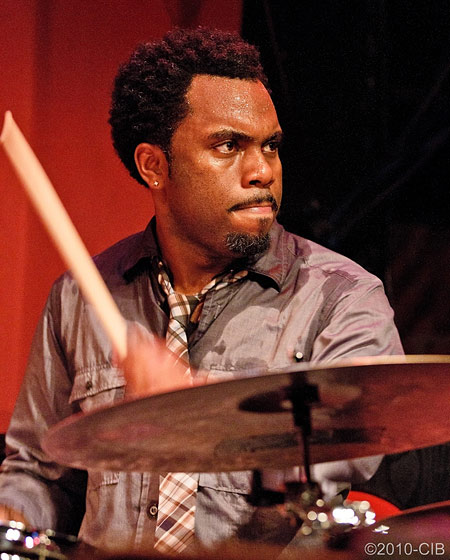
| Nate Smith |
Born and raised in Chesapeake, Virginia, his musical talent became
apparent at the age of eleven, after picking up the drums and learning
to play the piano by ear. After high school, he went on to earn a
percussion performance scholarship and pursued his musical studies at
James Madison University, where he received a B.S. in Media Arts and
Design in 1997. While still in college, Nate was recruited by the great jazz singer Betty Carter to participate in her esteemed Jazz Ahead program, which has produced an impressive list of alumni including Jason Moran, Cyrus Chestnut, Jacky Terrason, and Casey Benjamin, among many others. After college, he was invited to continue his studies at Virginia Commonwealth University as a member of the Carpenter Fellowship Program. In graduate school he met and performed with the legendary jazz bassist and composer Dave Holland. He continued to perform occasionally with Dave over the next few years, finally joining his GRAMMY-award winning Quintet and Big Band in 2003. In early 2004, he joined saxophonist Chris Potter’s group Chris Potter Underground, and has since recorded three albums with the ensemble. Since then, he has gone on to play or record with an array of fantastic and diverse artists, including: Ravi Coltrane, Jose James, Nicholas Payton, John Pattituci, Adam Rogers, Regina Carter, Mark de Clive-Lowe and Lionel Loueke. In 2012, Mr. Smith did a 35-City US/Europe tour with pop songwriting legend Joe Jackson. He has appeared on The Today Show, Late Night with Jimmy Fallon, The Late Show with David Letterman and Conan. Mr. Smith is also an esteemed educator, having served on the faculty of Betty Carter Jazz Ahead at The Kennedy Center 2013 and 2014 as well as The 2014 Thailand International Jazz Conference. Mr. Smith is also an accomplished R&B/Pop songwriter and producer, and in 2009 he formed his own production company, Waterbaby Music, Inc. For more information about Mr. Smith’s music, please visit www.waterbabymusic.com. |
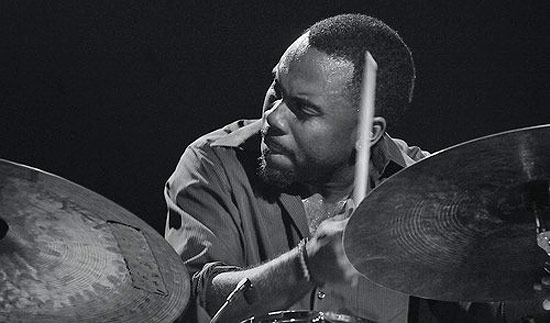
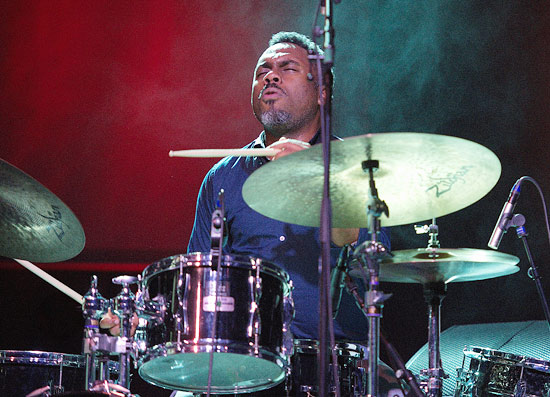
© Goffredo Loertscher
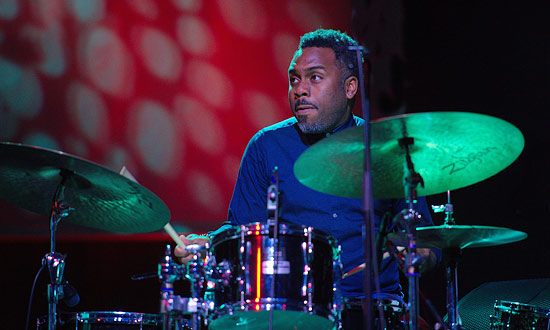
© Goffredo Loertscher
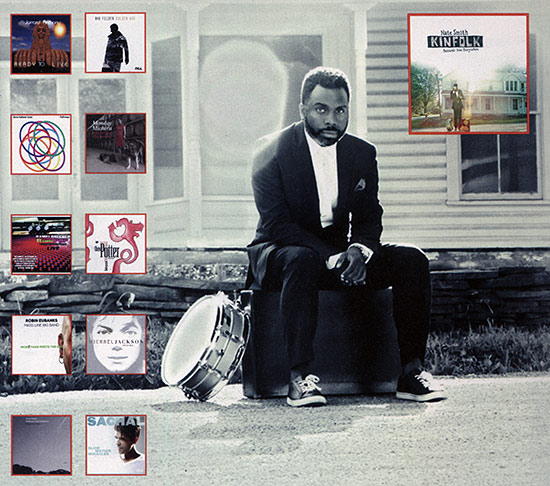
© Johnalynn Holland
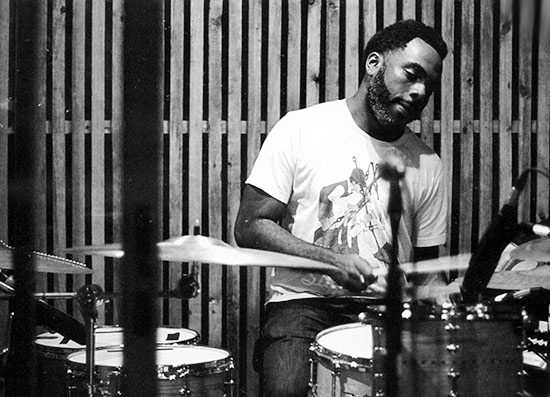
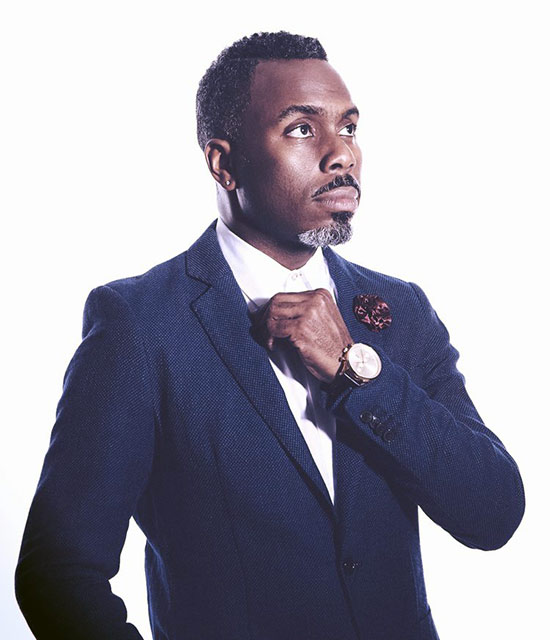
© Deneka Peniston
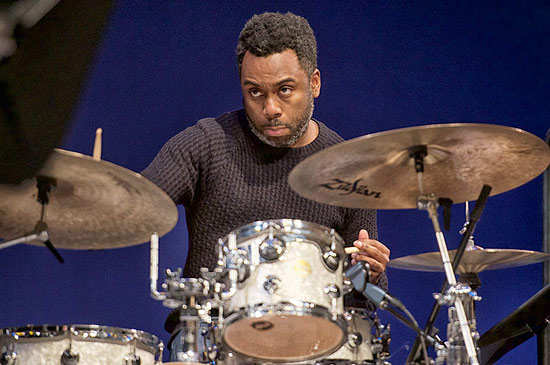
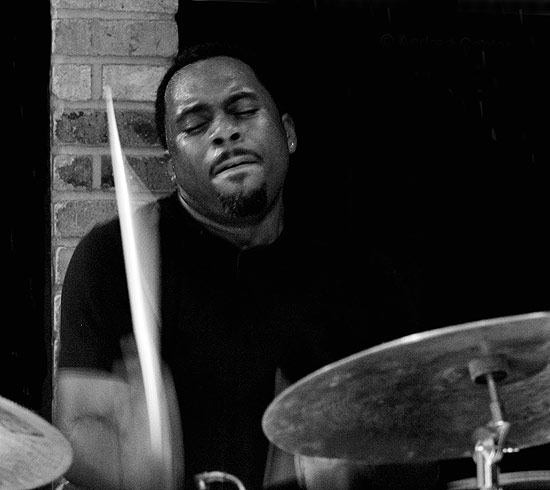
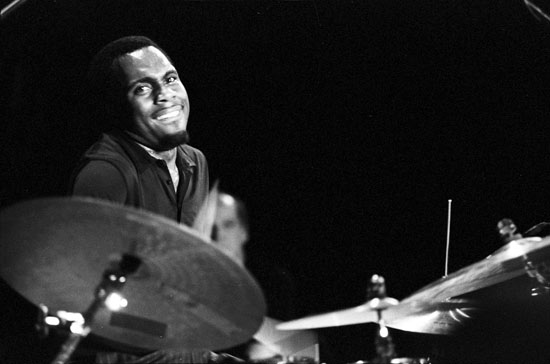
© Bernhard Ley
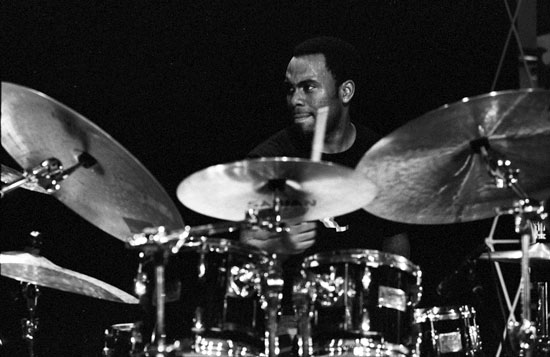
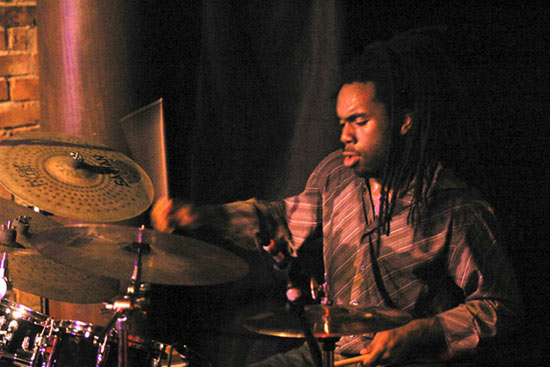
© Oskar Henn

© Bernhard Ley
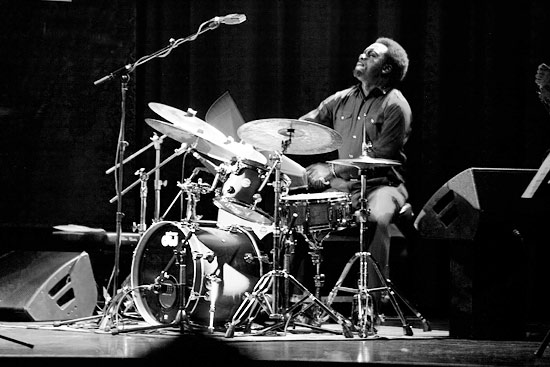
 © Bernhard Ley
© Bernhard Ley

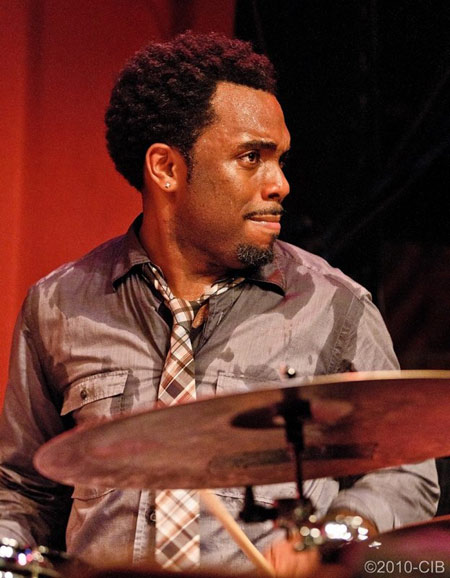
© Carlos Ibanez
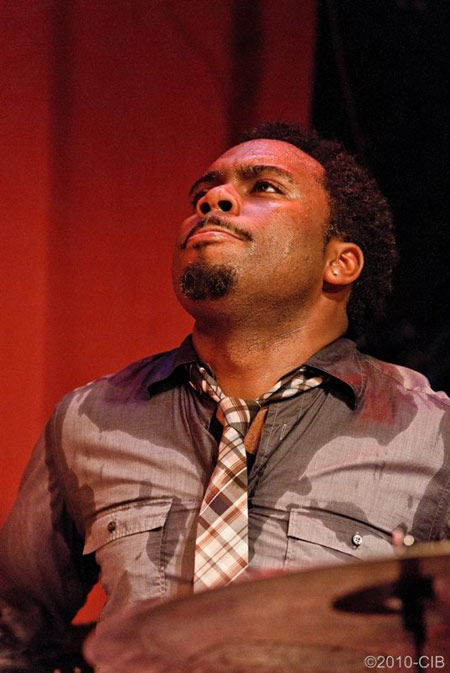
© Carlos Ibanez
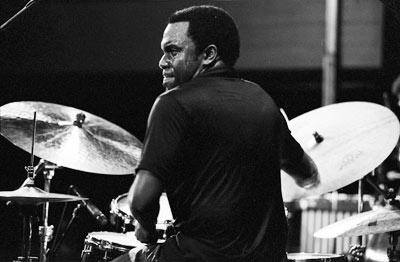

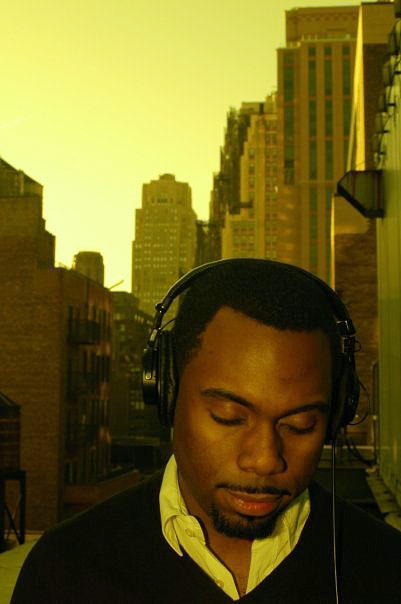
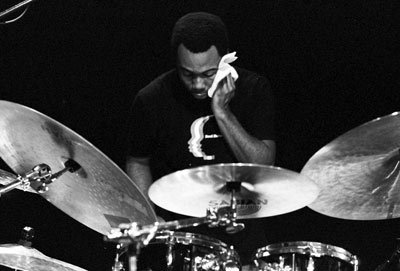
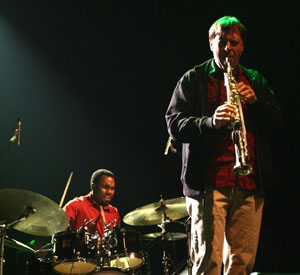
Nate Smith - Chris Potter

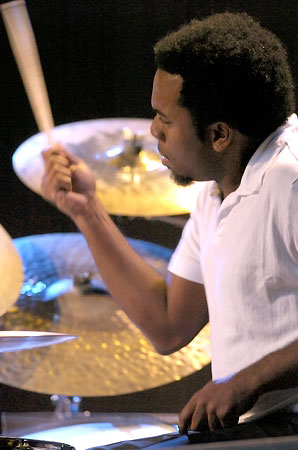
https://downbeat.com/news/detail/nate-smiths-universe-of-beats
Drummer Nate Smith’s Universe of Beats
by Ted Panken
January 17, 2019
Downbeat

A promotional video for Nate Smith’s solo drum collection Pocket Change describes it as an assortment of “beats, breaks and excursions.” (Photo: Steven Sussman)
Nate Smith’s solo drum suite, Pocket Change, marks the 44-year-old drummer’s second response to a question he asked himself several years ago, when bassist Dave Holland and saxophonist Chris Potter—with whom he made odd meters flow for much of the latter aughts—began to focus on new projects with different personnel.
“Drummers can get caught in the whirlwind of work,” Smith said over a recent lunch at a Harlem bistro. “But when the work with Dave and Chris slowed down, I was left with time to look for who I am without them.”
To find answers, Smith went to the piano, and began the process he described as “putting something together that tied all my experiences as a sideman into one thing. Once I decided to do that, and focused on which musicians to record with, I knew I had a direction.”
The result was 2017’s Kinfolk: Postcards From Everywhere (Ropeadope), a do-it-yourself production on which Smith augmented a strong unit with the voice of Gretchen Parlato, as well as some previous employers, including guitarists Lionel Loueke and Adam Rogers. Distinct melodies complement an array of Smith’s bespoke grooves, executed with drum-machine precision and a speculative attitude. As a producer, Smith was careful not to let the bells and whistles obscure the idiosyncratic personalities of his associates.
While conceiving Kinfolk, Smith was creating beats for various clients, including a collaboration with The Loop Loft (a sample shop that was acquired by Native Instruments in 2018). The Loop Loft will release select drum patterns as Nate Smith Vol. 3, Pocket Change, while Smith will self-release the proper album on vinyl and digital formats. He noticed a substantial uptick in Instagram-YouTube-Facebook engagement in response to promotional videos on which he plays “simple-sounding grooves that I try to switch up and change.” He mashed up jazz titans like Elvin Jones, Max Roach and Art Blakey, as well as contemporary influences like Omar Hakim, Bernard “Pretty” Purdie and Steve Gadd, and hip-hop avatars like J Dilla and Questlove.
Smith stated that for the initial Loop Loft production he felt a bit “constricted.” So, for his new project, he said he wanted “to open up the idea of playing on a grid, with a click track, then deconstructing to see how far I can stray and still land on the 1.”
Rather than bring a game plan into the studio, Smith spontaneously chose techniques to work with. On “Day In Dusk” (“something in 3 that modulates to 12/8”), he removes the snares, exploring the shades and colors of the toms. “Big Little Five” modulates between 5/8 and 5/4. On “Wobbly,” Smith employs his own way of swinging J Dilla’s “drunk on cognac” beats; on “What It Do” he breaks up the rhythm to mimic “the idea of lilts and swing in conversation.” His compressed voice enters the flow of “Paved,” while his refined production skills come to the fore in manipulated tonality of “Spressly So.”
At press time, a YouTube clip of Smith’s NPR Tiny Desk Concert posted in November 2017 had generated more than 519,000 views; a Pocket Change clip shot at Jazz Standard and posted in July had nearly 115,000 views. This enthusiastic online response reinforces Smith’s contention that “it’s important for drummers to make it known you have an imagination and important ideas that should be heard.” He continued: “Record labels, booking agents, management still can’t imagine the drummer-as-bandleader. But numbers don’t lie. Now, you can engage directly with your fans. ‘Hey, you like this music? This is my next show. Here are the tickets. You like this track? It’s on my album; here’s the link.’
“The Internet is a crowded place. But there’s room for all those voices. There’s lot of freedom if you engage directly with people.” DB
http://www.bigfishbookingco.com/nate-smith-kinfolk
WEBSITE FACEBOOK INSTAGRAM PROMO PHOTOS
Nate Smith + KINFOLK: Nate Smith: drums, percussion, fender rhodes, synths, sounds, Jon Cowherd: piano, fender rhodes, Fima Ephron: electric bass, Brad Allen Williams: guitars, Jaleel Shaw: alto and soprano saxophones, Amma Whatt: vocals.
*NEW ALBUM RELEASING FALL 2020*
TOUR DATES:
2020 TOUR DATES: Available Upon Request **BOOK NOW**
May 23, 2020: ATLANTA, GA / TBA
June 21, 2020: PITTSBURGH, PA / TBA
August 8, 2020: NEWPORT, RI / Newport Jazz Festival
2021 TOUR DATES: Available Upon Request **BOOK NOW**
“KINFOLK: POSTCARDS FROM EVERYWHERE” RELEASED FEBRUARY 2017 (ROPEADOPE)
THE
MUSIC OF NATE SMITH: AN EXTENSIVE VIDEO OVERVIEW, A CROSS SECTION OF
RECORDINGS, MUSICAL ANALYSIS AND COMMENTARY, PLUS VARIOUS INTERVIEWS
WITHNATE SMITH:







